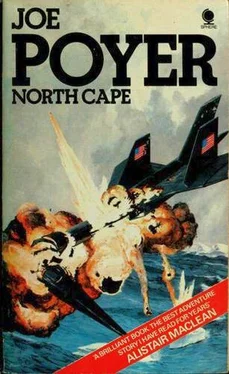The Tarim had been left behind now and the Pamir Plateau, thirteen to fifteen thousand feet high, was beginning. Teleman lifted the airplane accordingly, another thousand feet. The two Tibetan cities of Yarkand and Kashgar would be slipping past in a few minutes and he ran a check on all of his antidetection gear. He would pass between the two cities, in reality little more than villages, but villages with large Chinese garrisons. He would be out of sight of both towns, Yarkand to the south and Kashgar well to the north. The only tricky spot would be the narrow dirt highway that ran between the two, and he was counting on the heavy snowfall of the previous night to make it impassable; he would be out of Chinese territory before fighters could be scrambled to intercept, even if they could break through his radar fouling.
As he drew abreast of the city of Kashgar, out of sight to the north, he cleared a ridge and the vista of the Pamir Plateau opened up before him. Ahead, less than five minutes flying time, was the Tadzhik SSR border. The radar net was indicating no hostile aircraft anywhere within the 1600-mile diameter of its extent, but Teleman was not banking on that. Although the Tien Shan range, rising yet another nine thousand feet above his flight level, formed a perfect barrier to questing radio impulses, the entire Soviet and Chinese air forces combined could have hidden behind the wall of rock and he would never know it. It was times like these, he thought resignedly, that made him regret the excessive caution that would not allow him to interrogate the satellite system at will for fear of detection. Especially now, when the Soviets appeared to know about the project anyway. Because of the surrounding mountains, his radar could show him only dependable information on a very narrow cone leading directly up the valley to the border. In very short order, he knew, he would find out just how smart he had been. Teleman came out of the sheltering arms of the two mountain chains fighting for altitude. At 150,000 feet he leveled off and took a good look around. He had narrowed his counterdetection radar to a circle two miles in diameter — no sense in. advertising his presence. Teleman took a look at the weather gear and found the friendly ice cloud bank still stretched above him. Below, the plains of Turkestan were beginning to open up and he could just make out the hairline of the mighty Amu Dar Ya that tumbled and roared from the Hindu Kush to the Aral Sea a thousand miles northwest. The area over which he had just passed had been the fabled lands of the Kyber Pass and British soldiery of Kipling’s tales. But for Teleman there would be no glorious charge of British lancers to rescue him at the last possible moment. All he had was himself and the A-17 to depend on.
A sudden flurry of the computer tapes and there on the screen, closing in from the north, was a Falcon. This time the Soviet pilot had been caught napping. Teleman was ahead of rather than behind him. It was going to be a stern chase, he thought without humor as he flicked the series of switches that fired the ramjets and scrambled to 200,000 feet. The intruder dropped behind momentarily, then increased power and began to close up. As the A-17’s speed increased, the PCMS reacted accordingly, infusing Teleman with a calculated mix of hallucinogenic and barbiturate drugs. Within seconds Teleman was no longer thinking of the aircraft as a collection of metal and plastic components, but as an extension of himself. Actually, he did not feel on a conscious level that he had become the aircraft; it simply did not occur to him that there was any distinction. He was a part of the aircraft.
That bastard is gonna catch me, he thought in surprise. The contact readout chattered noisily to itself and showed less than forty minutes needed for missile range to be achieved. Teleman paused, finger on the throttle lever. It occurred to him that the Falcon could not maintain that speed and altitude for more than a few more minutes. Even as he was thinking, his body was reacting and lifting the A-17 to 225,000 feet and Mach 4.5. Simultaneously, the trailing Falcon slewed off and fell below, angling down and north to the nearest air base, while a second came streaking up from just ahead of the Last Soviet aircraft’s position. The chase was now shaping up into a gigantic chess match. They were going to run him down and if they failed at that, they would chase him into an area where fate, resembling a Falcon with a loaded and ready missile, would knock him out of the sky.
Teleman’s mind was working furiously, weighing various possibilities, while he tried to sort out the various loopholes in each that would allow him to beat the odds stacking up against him. He could continue to climb to maximum altitude and speed, cutting into his remaining fuel load (already shaved to the danger point by the long flight into Tibet), to and maybe below the poundage needed to achieve rendezvous; or he could try and outfox his energetic pursuers. He checked the computers to see how much longer he dared defer the decision: ten minutes.
He was now flying at 225,000 feet at Mach 4.5 and heading due west across the southernmost part of the Soviet Union. Teleman made a small correction for the rendezvous patterns he had set up. Immediately the Falcon followed suit. He flew on, keeping a wary eye on the plane below. After five minutes, the second Falcon began to drop down in a long glide to its base, and then made an extended turn to the north, dropping lower all the time. At once, a third Falcon came roaring up to take position, still well behind, but having gained nearly twelve miles on his predecessor. The contact readout did a quick readjustment and flipped up the “comforting” news that it would now require only eight minutes before missile range could be achieved, and two minutes left to make his decision. After that, he would be committed to a stern chase across Russia. This third intruder seemed a little more impatient than the first two, Teleman thought, watching him close in faster. Probably wanted to hog the glory of bringing down the Americanski spion . Samolot . Teleman grinned. Only four hundred miles separated the two craft now, and Teleman considered it time to take some positive action.
“Enough of this fooling around,” he muttered aloud, his voice sounding depressingly empty in the silence of the cockpit. Teleman went to work with the decoy missile setups, programing a new flight pattern into the computer. The computer would have to take care of the cubs, he thought. He was going to be too busy shortly to draw a decent breath. Teleman was about to give the Soviet detection systems a thorough workout. He knew that the observer would be busy with the optical tracking gear, but the pilot would have time to operate the semiautomated radar gear they would still carry. He doubted that they would remove all of that, as it would at least provide the approximate area in which to search. Obviously, the optical gear had a range of at least four hundred miles since that was the distance at which they had picked him up as he came out of the mountains. At five hundred miles, with his own ECM now narrowed to a mile in diameter, he would be only a hole in the sky to the Falcon radar. But he could really give them a red herring to play with. Teleman chuckled. A red herring for Reds. Quite appropriate. He began to flick the ECM switch controlling the antiradar gear on and off in a haphazard pattern, hopefully making the Soviet pilot think that his own radar gear was breaking through the electromagnetic interference the American gear was causing. At the same time he put the A-17 into a steep downward curve south and continued around into a tighter and tighter spiral, all the while keeping a close watch on the digital counter clicking off the closure rate to missile range. On the radar scope, the Russian pilot smoothly followed suit, never hesitating once. The flickering image of the A-17 must have been clearly visible on the radar scope. Teleman followed the course of the Falcon, waiting patiently. He was counting on the natural impatience, coupled with anxiety over losing the target, that he knew the Russian pilot must now be feeling. He had just begun the third spiral when it happened. He saw the Falcon clearly increase speed and go into a tighter and faster curving descent than the A-17. It was so impetuous that he did hot even need the readout to tell him that the Russian had moved, moved to catch him within missile range by turning faster and steeper. Teleman waited a moment longer to be sure the Russian was committed.
Читать дальше












